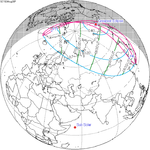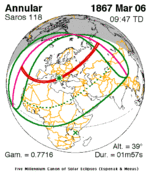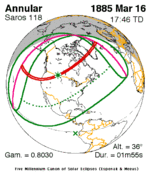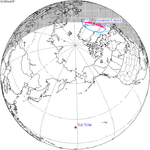Solar eclipse of April 8, 1921
| Solar eclipse of April 8, 1921 | |
|---|---|
| Type of eclipse | |
| Nature | Annular |
| Gamma | 0.8869 |
| Magnitude | 0.9753 |
| Maximum eclipse | |
| Duration | 110 s (1 min 50 s) |
| Coordinates | 64°30′N 5°36′E / 64.5°N 5.6°E |
| Max. width of band | 192 km (119 mi) |
| Times (UTC) | |
| Greatest eclipse | 9:15:01 |
| References | |
| Saros | 118 (63 of 72) |
| Catalog # (SE5000) | 9330 |
An annular solar eclipse occurred at the Moon's descending node of orbit on Friday, April 8, 1921, with a magnitude of 0.9753. A solar eclipse occurs when the Moon passes between Earth and the Sun, thereby totally or partly obscuring the image of the Sun for a viewer on Earth. An annular solar eclipse occurs when the Moon's apparent diameter is smaller than the Sun's, blocking most of the Sun's light and causing the Sun to look like an annulus (ring). An annular eclipse appears as a partial eclipse over a region of the Earth thousands of kilometres wide. Annularity was visible from northern Scotland, northwestern tip of Norway, and islands in the Arctic Ocean in Russian SFSR.
Related eclipses[edit]
Eclipses in 1921[edit]
- An annular solar eclipse on April 8, 1921.
- A total lunar eclipse on April 22, 1921.
- A total solar eclipse on October 1, 1921.
- A partial lunar eclipse on October 16, 1921.
Metonic[edit]
- Preceded by: Solar eclipse of June 19, 1917
- Followed by: Solar eclipse of January 24, 1925
Tzolkinex[edit]
- Preceded by: Solar eclipse of February 25, 1914
- Followed by: Solar eclipse of May 19, 1928
Half-Saros[edit]
- Preceded by: Lunar eclipse of April 1, 1912
- Followed by: Lunar eclipse of April 13, 1930
Tritos[edit]
- Preceded by: Solar eclipse of May 9, 1910
- Followed by: Solar eclipse of March 7, 1932
Solar Saros 118[edit]
- Preceded by: Solar eclipse of March 29, 1903
- Followed by: Solar eclipse of April 19, 1939
Inex[edit]
- Preceded by: Solar eclipse of April 26, 1892
- Followed by: Solar eclipse of March 18, 1950
Triad[edit]
- Preceded by: Solar eclipse of June 7, 1834
- Followed by: Solar eclipse of February 7, 2008
Solar eclipses of 1921–1924[edit]
This eclipse is a member of a semester series. An eclipse in a semester series of solar eclipses repeats approximately every 177 days and 4 hours (a semester) at alternating nodes of the Moon's orbit.[1]
The partial solar eclipse on July 31, 1924 occurs in the next lunar year eclipse set.
| Solar eclipse series sets from 1921 to 1924 | ||||||
|---|---|---|---|---|---|---|
| Descending node | Ascending node | |||||
| Saros | Map | Gamma | Saros | Map | Gamma | |
| 118 | April 8, 1921 Annular |
0.8869 | 123 | October 1, 1921 Total |
−0.9383 | |
| 128 | March 28, 1922 Annular |
0.1711 | 133 | September 21, 1922 Total |
−0.213 | |
| 138 | March 17, 1923 Annular |
−0.5438 | 143 | September 10, 1923 Total |
0.5149 | |
| 148 | March 5, 1924 Partial |
−1.2232 | 153 | August 30, 1924 Partial |
1.3123 | |
Saros 118[edit]
This eclipse is a part of Saros series 118, repeating every 18 years, 11 days, and containing 72 events. The series started with a partial solar eclipse on May 24, 803 AD. It contains total eclipses from August 19, 947 AD through October 25, 1650; hybrid eclipses on November 4, 1668 and November 15, 1686; and annular eclipses from November 27, 1704 through April 30, 1957. The series ends at member 72 as a partial eclipse on July 15, 2083. Its eclipses are tabulated in three columns; every third eclipse in the same column is one exeligmos apart, so they all cast shadows over approximately the same parts of the Earth.
The longest duration of totality was produced by member 34 at 6 minutes, 59 seconds on May 16, 1398, and the longest duration of annularity was produced by member 59 at 1 minutes, 58 seconds on February 23, 1849. All eclipses in this series occur at the Moon’s descending node of orbit.[2]
| Series members 57–72 occur between 1801 and 2083: | ||
|---|---|---|
| 57 | 58 | 59 |
 February 1, 1813 |
 February 12, 1831 |
 February 23, 1849 |
| 60 | 61 | 62 |
 March 6, 1867 |
 March 16, 1885 |
 March 29, 1903 |
| 63 | 64 | 65 |
 April 8, 1921 |
 April 19, 1939 |
 April 30, 1957 |
| 66 | 67 | 68 |
 May 11, 1975 |
 May 21, 1993 |
 June 1, 2011 |
| 69 | 70 | 71 |
 June 12, 2029 |
 June 23, 2047 |
 July 3, 2065 |
| 72 | ||
 July 15, 2083 | ||
Metonic series[edit]
The metonic series repeats eclipses every 19 years (6939.69 days), lasting about 5 cycles. Eclipses occur in nearly the same calendar date. In addition, the octon subseries repeats 1/5 of that or every 3.8 years (1387.94 days).
| 22 eclipse events, progressing from north to south between April 8, 1902, and August 31, 1989: | ||||
|---|---|---|---|---|
| April 7–8 | January 24–25 | November 12 | August 31-September 1 | June 19–20 |
| 108 | 114 | 116 | ||
 April 8, 1902 |
 August 31, 1913 |
 June 19, 1917 | ||
| 118 | 120 | 122 | 124 | 126 |
 April 8, 1921 |
 January 24, 1925 |
 November 12, 1928 |
 August 31, 1932 |
 June 19, 1936 |
| 128 | 130 | 132 | 134 | 136 |
 April 7, 1940 |
 January 25, 1944 |
 November 12, 1947 |
 September 1, 1951 |
 June 20, 1955 |
| 138 | 140 | 142 | 144 | 146 |
 April 8, 1959 |
 January 25, 1963 |
 November 12, 1966 |
 August 31, 1970 |
 June 20, 1974 |
| 148 | 150 | 152 | 154 | |
 April 7, 1978 |
 January 25, 1982 |
 November 12, 1985 |
 August 31, 1989 | |
Notes[edit]
- ^ van Gent, R.H. "Solar- and Lunar-Eclipse Predictions from Antiquity to the Present". A Catalogue of Eclipse Cycles. Utrecht University. Retrieved 6 October 2018.
- ^ "NASA - Catalog of Solar Eclipses of Saros 118". eclipse.gsfc.nasa.gov.
References[edit]
- Earth visibility chart and eclipse statistics Eclipse Predictions by Fred Espenak, NASA/GSFC




